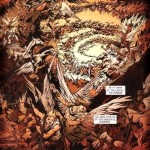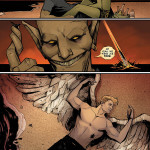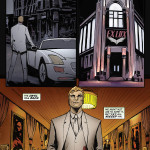I was going to rant for a bit about all the ways that the Lucifer TV series is different from the source material (originally from Neil Gaiman, and then spun off very capably by Mike Carey), but I’ve decided that’s not a very productive discussion. There’s no point to making a carbon copy of the original stories in a new format, and even if you could it wouldn’t guarantee that the results will be good. The TV show is going to have to succeed or fail on its own merits.
Besides, there are some positive things that have come out of the interest generated by the show. Like the fact that bookstores have started carrying the Lucifer graphic novels again, or Vertigo’s brand new comic book series written by Holly Black, continuing the story of the fallen angel and former ruler of Hell. So let’s talk about those, because Mike Carey’s series is one of my all-time favorites, and Holly Black’s continuation is growing on me with every issue.
A little backstory: Lucifer failed to overthrow Heaven, and after ten billion years he decided that ruling Hell was just serving God in a different zip code. So he quit, and opened a bar in Los Angeles. A one-time payment for services rendered gave Lucifer a passageway to the void, which he was able to eventually convert into his own universe, one that was entirely separate from God.
That takes us to the second graphic novel in Mike Carey’s eleven-book series, and it’s only the start of Lucifer’s plans.
The rest of Mike Carey’s series follows the Morningstar as he plays a very long game. The story also brings in a cast of thousands: angels, demons, gods and goddesses from several different pantheons, a sentient deck of Tarot cards, and all the hapless mortals caught up in between. If I were to go into story specifics it would degenerate into a point-by-point discussion of all my favorite storylines: the trip to a Japanese underworld to retrieve Lucifer’s wings, a lady-demon of Hell having an affair with a damned soul just to be a bitch, the centaur-girl’s story in book four, a surprisingly touching story of a monster dragging a timid shopkeeper into her nightmarish home world, the Stitchglass Demon story, Lucifer and his demon lover(?) Mazikeen having a picnic in the new Garden of Eden (actually pretty much anything at all involving Lucifer and Mazikeen).
Come to think of it, there are a surprising number of characters who are fiercely loyal to Lucifer for one reason or another. On the surface it’s easy to see what draws people to him. He’s intelligent, handsome, sometimes amusing (in a sardonic way; he makes a lot of cutting remarks), and very charming when he wants to be.
He also – and this is very important – absolutely. Doesn’t. Care. About anyone.
Elaine: “He saved my life twice. He’s the only grown-up I know who keeps his promises.”
Michael: “Yes. It is a point of pride for him. But please, don’t mistake it for a virtue.”
Lucifer doesn’t lie. But he doesn’t have a problem with holding back information either. He’s a master manipulator, and quite a few characters find out how much sympathy he has for people who are hurt or killed because of something he’s done: exactly zero. One character caught by the fallout from Lucifer’s plans realizes that it’s not like the devil thinks the consequences were worth it; he never thinks about the consequences in the first place. “I was just the hat on a stick you wave around to see where the enemy’s shots are coming from.” Lucifer does some truly horrible things to people who get in his way (or annoy him. Or happen to be standing too close at the wrong time) but most of the time the bad things that happen to bystanders aren’t even something he notices.
![]() It’s the kind of characterization that makes you think about the nature of evil. Lucifer keeps his word, he never lies, and he does save lives occasionally. Do good results excuse really bad intentions (or at least self-serving ones), or are they any better than terrible results from good intentions? He’s the main character of the story, so the reader ends up rooting for him (or at least I did), but then you keep coming face-to-face with the fact that he doesn’t do anything for anyone unless he can get something out of it. In his mind he’s the most important person in the universe, and he just doesn’t have any regard for anyone else.
It’s the kind of characterization that makes you think about the nature of evil. Lucifer keeps his word, he never lies, and he does save lives occasionally. Do good results excuse really bad intentions (or at least self-serving ones), or are they any better than terrible results from good intentions? He’s the main character of the story, so the reader ends up rooting for him (or at least I did), but then you keep coming face-to-face with the fact that he doesn’t do anything for anyone unless he can get something out of it. In his mind he’s the most important person in the universe, and he just doesn’t have any regard for anyone else.
Well, except maybe for Mazikeen. I ship the heck out of Lucifer and Mazikeen. Maz is a bad-tempered, vicious, powerful demon. As a member of the Lilim, her face is half-beautiful, half rotting skull by choice. She dislikes everyone, and she’s been in love with Lucifer since her first appearance in Neil Gamain’s Sandman. Their relationship is never really defined. It’s physical, but we don’t get any real details other than the occasional kiss. Lucifer obviously respects her as a warrior and a loyal servant, and maybe there’s something more. But he never once does anything for her, even when she asks unless, again, it’s something that will benefit him somehow. The most we can say about their romance is that Mazikeen loves him, and Lucifer allows it.
The art by Peter Gross and Ryan Kelly defines this series for me. The quality goes up and down; sometimes a few panels will look a little rushed, but then they’ll do a panel filled with gorgeous detail, from sprawling scenes of Hell to intricate designs in a Japanese-style room, and the way they picture all of the characters just works for me (especially any scenes with Lucifer and Mazikeen. Sorry, I’ll stop now.) The series brought in guest artists like the expressive Dean Ormston and the stylized work by Marc Hempel. There’s also stunning cover art by Christoper Moeller, and a flat-out gorgeous single issue by P. Craig Russel. If nothing else, you need to check out the first story in the eighth graphic novel. It’s sort of Lucifer’s origin story, and Russel is incapable of drawing anything that isn’t pretty.
![]() I was happy to see that the new series written by Holly Black picks up right where the Mike Carey’s series left off. It also seems to have kept things consistent with how Carey left them, even if it does rob the original ending of a little of its power. (And oh boy, that ending. I was amused to hear about certain groups protesting the treatment of Lucifer in the TV series. Their heads would explode if they read the graphic novels. I’m about as fanatical as an afternoon nap, and I still found the portrayal of God deeply problematic. It’s not as awful as the way God appears in Garth Ennis’s Preacher series – good Lord, it doesn’t even come close – but still, you have been warned.)
I was happy to see that the new series written by Holly Black picks up right where the Mike Carey’s series left off. It also seems to have kept things consistent with how Carey left them, even if it does rob the original ending of a little of its power. (And oh boy, that ending. I was amused to hear about certain groups protesting the treatment of Lucifer in the TV series. Their heads would explode if they read the graphic novels. I’m about as fanatical as an afternoon nap, and I still found the portrayal of God deeply problematic. It’s not as awful as the way God appears in Garth Ennis’s Preacher series – good Lord, it doesn’t even come close – but still, you have been warned.)
We’re three issues into the new Lucifer series and I’m enjoying it a lot. The artwork by Lee Garbett is sharp and vivid; he packs a lot of meaning into very simple lines, precise cross-hatching and Antonio Fabela’s vibrant colors. Holly Black’s story casts Lucifer in an adventure/murder mystery, where the fallen angel teams up with a now-human Gabriel (I’m hoping for more details about that in future issues) to solve the mystery of Who Murdered God. I do miss how terrifyingly all-powerful Lucifer used to be (one of my favorite scenes in the original series had an entire army of demons halting in mid charge because the Morningstar was standing in the way) but this series promises to be pretty interesting. I hope it doesn’t go the route of bad-guy-who-really-just-wants-to-be-redeemed, because the most believable part of the Lucifer character for me is the fact that by design he’s completely unredeemable, if for no other reason than the fact that he’s never going to be able to forgive God for being the one who made him in the first place.






